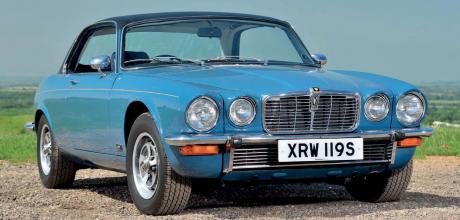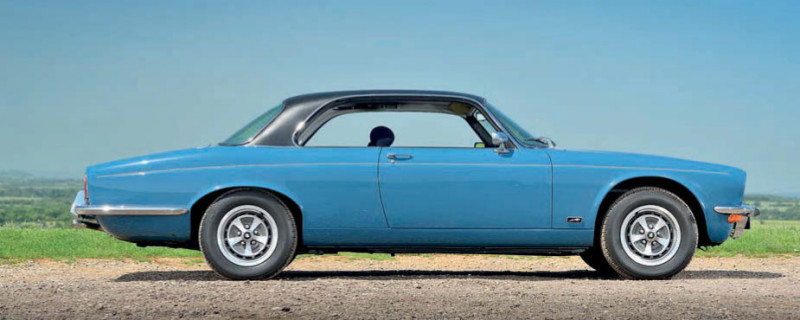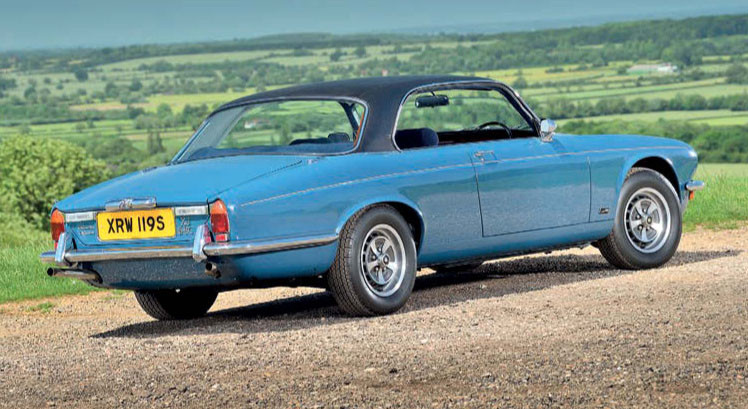Buyers Guide Jaguar XJC

While it only sold for a couple of years new, these days the pillarless Jaguar XJC is one of the most desirable XJs as a classic. Here’s what you need to know to get a good one.
Words: Sam Skelton
Photography: Matt Woods
PILLAR OF SOCIETYBUYING GUIDE: JAGUAR XJC
The quiet elegance of the two-door XJ, the car which urban rumour says was William Lyons’ own favourite Jaguar.
The XJC was always an integral part of the Jaguar XJ plan. One prototype even exists as a Series 1 – the plan was to launch the car long before its 1973 unveiling. But problems sealing the pillarless windows and a focus on the more profitable saloon models meant that it was postponed until just before the launch of the XJ-S, a model which many inside Jaguar felt represented internal competition. The window sealing issues were eventually solved with a series of pulleys and cables which would press the side windows in toward the door seals at speed, removing their tendency to pull outwards and create wind noise.

As launched, the XJC was a Series 2 – taking advantage of the 1973 facelift which brought the bumper height up, reduced the depth of the grille and gave the car a revised interior. This meant it could look fresh alongside competition including the Mercedes-Benz 280CE C123 and the BMW CSi E24. While entry level saloons got a 3.4-litre engine, the XJC was only ever available with 4.2-litre XK and 5.3-litre V12 units – initially badged as XJ6C and XJ12C accordingly, but rebranded as the XJ4.2C and XJ5.3C when marketing concluded that advertising 12 cylinders in the wake of a fuel crisis would be deemed profligate. No, we’re not sure how advertising a 5.3-litre engine helped matters...

All XJCs had a vinyl roof from the factory and while many wags suggested that this was to hide the seam in the shortened saloon roof, there was in fact no engineering reason to hide the panel and a vinyl roof was fitted purely for marketing reasons. Such a feature was deemed stylistically desirable, and it has become one of the model’s best recognised features alongside its windows and thicker C-pillar design. Alongside the Jaguar models sat a pair of Daimlers; the Sovereign Coupe and the Double Six Coupe – each with slightly different trim and a higher price than that of its Jaguar equivalent. This range of four models lasted just two years in production with the last car rolling off the Browns Lane production line in 1977. While they had proved an effective halo for the XJ saloon range, buyers in search of something swish were turning to the XJ-S and those in need of greater practicality chose a standard XJ saloon. The XJC was left in a ‘no man’s land’ of poor sales and profitability, and by the launch of the Series 3 XJ in 1979 it was but a distant memory for the sales and marketing men. Just 10,426 had been produced.

WHAT TO LOOK FOR
BODYWORK
It should come as no surprise to anyone old enough to remember Series XJs in regular use that they like to corrode – and there’s a lot of metal that needs to be looked at in order to check you’ve got a good one. Fortunately, the XJ range is wellserved in terms of bodywork, and even the XJC-specific bits can be had if you’re willing to pay the price. That price can sometimes be unpalatable – we found rear wings, for instance, at £3484 each – but it does make restoration far more viable than for cars where panels simply don’t exist.
But you don’t want to spend the same on a wing as you might conceivably spend on a second classic Jaguar, so it’s better to check it’s good to begin with. And the places to start are the structural areas – the inner and outer sills, the floorpans, any box sections you can get to, the front subframe mountings and the rear suspension mounting points. Check too for rot around the front and rear screen surrounds, often caused by moisture trapped behind the rubbers or under the vinyl roof. If there’s rot here it’s far worse than it looks, and the screens have to come out to sort it. Leaks here can also let water in and cause damage to trim.
ENGINE
There’s nothing really to be scared of under the bonnet here, as the XJC uses the same engines as the standard XJ saloon range. That is to say, 4.2-litre variants of the XK six-cylinder and 5.3-litre variants of the Jaguar V12.
XKs can burn a bit of oil – it’s a character trait and not necessarily a sign of anything nasty. But listen for timing chain issues as chains can break, and a rattle is usually the first sign that something is amiss. It’s not a cheap job, so negotiate if it’s necessary. Listen for bearing noise when cold, and when up to temperature you need to look for around 40psi on the oil pressure gauge at around 3000rpm.
If you’re looking at a V12, listen for knocking and check for excessive smoke. They’re usually quiet, and only a loose timing chain should be audible at worst. If it’s noisy, walk away. Likewise if there are head gasket problems walk away, and if the many belts and hoses are past their best you’re probably better off looking for another example.
INTERIOR
Leather and walnut are two of the most expensive materials to replace when restoring a classic – but fortunately two of the easiest to find a craftsman to undertake. Almost all XJCs came with leather trim, though a handful came with velour which is reasonably hard wearing and comfortable.
If there’s been any water ingress as a result of screen rot things may smell damp, and if the carpets are moist to the touch it’s likely to confirm this. If it’s the case, it’s not going to be cheap to put right. The odds are that with water ingress there will be moisture damage to the lacquered finish of the walnut dashboard too, and this certainly won’t be cheap to repair. As with any old car, buy the best you can afford and if there’s anything amiss inside, use it as a negotiating lever.
GEARBOX
While there were a handful of manuals, the majority of 4.2-0litre XJCs and all 5.3-litre cars will be automatic – using a Borg-Warner transmission, though some very late V12s might have a GM400 unit. The Borg Warner is generally reliable, but check that changes are smooth and that the kickdown works as intended. Any hesitation or jumping out of gear is bad news, and you should walk away unless the car is seriously cheap. It’s gearbox rebuild time, and this needs factoring into the price.
BRAKES
Inboard rear brakes can be a difficult job for the home mechanic, though experts are well-versed in their rebuilding. They can seize through lack of use so test them. Handbrake adjustment is above the rear discs and a nightmare job, so test the handbrake thoroughly if you can. The location of the brakes also makes them vulnerable to leaking differentials, so check there’s no oil on the pads.
STEERING & SUSPENSION
The independent rear suspension system is complicated by 1970s standards and can be hard to work on, with several rubber joints, mountings and universal joints – all of which can wear. Tired suspension can lead to uneven tyre wear, so check the tyres as they’ll offer a clue as to the condition of the suspension. Clunking when pulling away could be wear in the propshaft or halfshafts, but could also mean that the subframe mountings are parting from the floorpans.
It’s one of those cars where a professional inspection on a ramp will pay dividends, so if you’re unsure get it inspected.
Steering is light but should feel reasonably direct. Theoretically it’s a durable system but if the rack needs a rebuild seal kits are available.
VALUES
If you were hoping an XJC could be yours for the £10,000 or so that you might spend on a reasonable saloon, sorry to let you down. These cars have finally been noticed, and values are heading quickly northwards.
Even something tatty but usable can fetch five figures these days, with the very nicest XJ6Cs fetching almost £25,000 and the best XJ12Cs a couple of grand more expensive.
On average, Daimler prices sit between £500 and £1500 more than those of the equivalent Jaguar models. And this is one of those cars where buying a cheap one and restoring it will never save you money. To get the right sort of paint finish, the right sort of interior finish on these cars won’t be cheap, and it’s very easy to sink north of £50,000 into an XJC restoration if the car needs any sort of serious work.
If you want to save money, you spend as much as you can when buying and you look after it. But the good news is values are still going up, so if you choose to spend around £20,000 on a decent XJ6C now you’ll certainly not lose out when you come to sell it.
VERDICT
The Jaguar XJC is that rare car, a 1970s Jaguar that manages to avoid the Arthur Daley stereotype and has aged as gracefully as its manufacturer had intended. Where else will you find svelte pillarless lines melded to the fi nest walnut and leather interior this side of a Rolls-Royce Corniche, with excellent mechanical parts support and a pair of thriving owners clubs eager to help would-be owners with every detail of their purchase and running their classics?
The XJC offers exclusivity beyond that of the standard XJ without the potentially ruinous parts costs of an XK or the asking price of an E-Type, it’s the classic Jaguar we’ve all been looking for and the market is starting to wake up to its desirability.
If you want to be even more exclusive and to be part of the story of Britain’s oldest motor manufacturer, it’s possible to buy Daimler Sovereign and Double Six branded coupes – sadly the Vanden Plas model never proceeded beyond a sole prototype but by 1970s standards the standard models were specified to an excellent standard. You’ll miss no creature comforts in here.
Values as a result have started to rise, and gone are the days of finding a tidy example in the back of a local paper for £5000.
But we see no reason to suspect a reversal of the trend, and the XJC is one of the few classics we think will actually make you money as you enjoy it.
If you can afford to buy one, there really is no good reason not to.
Nearly all XJCs came with the vinyl roof. In V12 form, the elegant coupe glides to an effortless 140mph. V12 is a masterpiece, but the packed engine bay makes even routine tasks labour-intensive. Cabin is pure XJ saloon. Velour trim is a rare option. Elegant pillarless style was reputedly a favourite of Jaguar founder William Lyons.
INSURANCE COSTS
Quotation supplied by Lancaster Insurance
1975 XJC 4.2, value £20,000: £87.10 or £107.10 with Agreed ValueBased on 45-year old, with a second vehicle. It’s garaged, covers 3000 miles a year and lives in an SP2 postcode. They have no claims or convictions, are a club member, and are employed as a marketing manager. Disclaimer: Policy benefits, features and discounts offered may vary between insurance schemes or cover selected and are subject to underwriting criteria. An additional charge may be payable.Subject to underwriting criteria. www.lancasterinsurance.co.uk 01480 809176SPECIFICATIONS
- MODEL JAGUAR XJC 4.2 / JAGUAR XJC 5.3
- ENGINE 4235cc I6 / 5343cc V12
- TRANSMISSION Three-speed automatic
- MAX POWER 167bhp at 4250 rpm / 288bhp at 5750rpm
- 0-60MPH 8.7secs / 7.4secs
- MAX SPEED 116mph / 140mph
- LENGTH 4.85m / 4.85m
- LENGTH 4013mm / 4013mm
- WEIGHT 1750 kg / 1885kg
OR MAYBE..?
Paul Wager, Group Editor BMW 3.0 CS E9
I’ve had a soft spot for the E9 BMW models ever since was editor of a BMW magazine, back in the days when they were still an affordable prospect. And while the engine is smaller and the specification more sparse than the Jaguar, there’s no doubting that the car which gave the world the BMW ‘Batmobile’ racers which helped cement BMW's motorsport credentials is a fearsomely capable car from behind the wheel. Everyone remembers the 6-Series today and this is the car which came before.
Adrian Evanson, Lancaster InsuranceMercedes-Benz 280CE W123
The Mercedes-Benz ticks all the boxes the Jaguar ticks for me, but offers better value where Jaguar prices have begun to climb, alongside better parts availability and a more practical overall shape. The XJ is too long for the average garage while a W123 will fi t with ease. Its 2.8-litre engine makes it a competitor for the XJ 4.2C at best, rather than the V12 cars, but for your money you’ll get an excellent example of a classic which can be used every day. Mercedes wasn’t new to pillarless cars when this was built either, so the odds are that it’s a better developed car and the average example will be more wind resistant


Very cool styling JAG coupe — like XJS — but more jaguar-designed